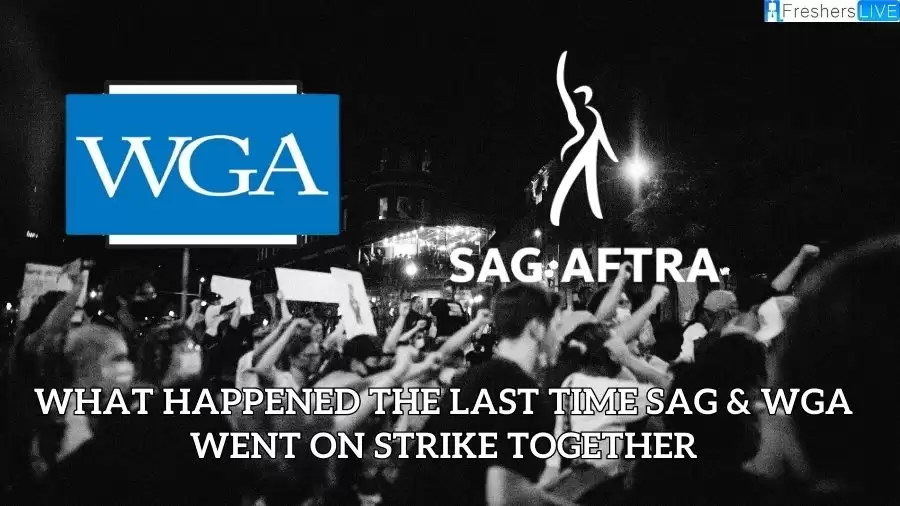What Happened the Last Time SAG & WGA Went on Strike Together?
by Abinaya
Updated Jul 15, 2023

What Happened the Last Time SAG & WGA Went on Strike Together?
The last time the Screen Actors Guild (SAG) and the Writers Guild of America (WGA) went on strike together was in 1960. The WGA initiated the strike on January 16, demanding better compensation, including contributions to health and pension funds, increased wages, and higher residuals for their work shown on television or via reruns.
Following suit, SAG began their own strike on March 7, 1960, focused on securing residuals for films sold to TV networks. This historic event marked the industry's first instance of a double strike. SAG's strike concluded on April 18, 1960, with an agreement that waived residual payments for films made before 1960.
Instead, they gained residuals for all films made from 1960 onwards and received a one-time payment of $2.25 million from producers, which was used to establish a SAG pension and health plan. The writers' strike, however, lasted until June 12, 1960. During negotiations, the WGA achieved significant gains, including groundbreaking provisions such as the introduction of residuals for theatrical motion pictures.
This involved receiving 1.2% of the license fee when features were licensed for television. The WGA also secured an independent pension fund, an industry health insurance plan, and 4% residuals for both domestic and foreign television reruns, as outlined on the WGA website.
When was the Last Time SAG and WGA Went on Strike?
The 1960 strikes involving SAG and WGA saw notable figures taking part in the labor disputes. Ronald Reagan, who would later become the President of the United States, played a key role as the President of SAG and led the negotiations with Hollywood studios. SAG's strike had a significant impact on the film industry, causing production halts on eight feature films.
Among the affected movies were prominent works such as Elizabeth Taylor's Butterfield 8, Gina Lollobrigida's Go Naked in the World, Jack Lemmon's The Wackiest Ship in the Army, and Marilyn Monroe's Let's Make Love. These films, along with many others, had notable stars, including Bing Crosby and Fred Astaire, who actively participated in the work stoppage alongside their fellow actors.
What is SAG-AFTRA?
The Screen Actors Guild – American Federation of Television and Radio Artists (SAG-AFTRA) is a prominent labor union that represents around 160,000 professionals in the film, television, radio, and media industries worldwide. Its membership includes actors, journalists, radio personalities, recording artists, singers, voice actors, internet influencers, fashion models, and other media professionals.
SAG-AFTRA was established on March 30, 2012, through the merger of two well-known unions: the Screen Actors Guild (SAG), founded in 1933, and the American Federation of Television and Radio Artists (AFTRA), initially formed in 1937 as the American Federation of Radio Artists and later incorporating television artists in 1952.
As a member of the AFL-CIO, the largest federation of unions in the United States, SAG-AFTRA operates within a broader network of labor organizations. Additionally, the union is affiliated with the International Federation of Actors (FIA), an international organization that represents performers globally. SAG-AFTRA plays a crucial role in safeguarding the rights and interests of its members.
The union negotiates collective bargaining agreements, sets industry standards for compensation, working conditions, and benefits, and provides support and resources to its diverse membership. Through its advocacy and representation, SAG-AFTRA strives to promote fair treatment, protect intellectual property rights, and ensure the well-being and professional development of its members in an ever-evolving media landscape.
What is WGA?
The Writers Guild of America (WGA) is a collective body that consists of two distinct labor unions representing writers across various platforms such as film, television, radio, and online media. These unions are the Writers Guild of America, East (WGAE) based in New York City and affiliated with the AFL-CIO, and the Writers Guild of America West (WGAW) located in Los Angeles.
While the WGAE and WGAW are separate entities with their own operations, they engage in collaborative efforts on certain matters such as contract negotiations and coordinated strike actions. This unified approach allows them to advocate for the rights and interests of writers in the entertainment industry.
The WGAE and WGAW play a vital role in protecting the professional and creative rights of writers. They negotiate collective bargaining agreements on behalf of their members to secure fair compensation, working conditions, and benefits. These agreements establish industry standards and help ensure that writers are properly recognized and compensated for their contributions.
Additionally, the Writers Guild of America supports its members by providing resources, legal assistance, and professional development programs. It serves as a platform for writers to connect, share knowledge, and address common concerns within the industry. Through their ongoing efforts, the WGAE and WGAW strive to promote the value of writers and their significant contributions to the storytelling and entertainment landscape.
What Happened the Last Time SAG & WGA Went on Strike Together? - FAQ
The last time SAG and WGA went on strike together was in 1960.
The WGA demanded better compensation, including contributions to health and pension funds, increased wages, and higher residuals for their work shown on television or via reruns.
SAG's strike aimed to secure residuals for films sold to TV networks.
The WGA strike lasted until June 12, 1960.
The WGA achieved significant gains, including the introduction of residuals for theatrical motion pictures, an independent pension fund, an industry health insurance plan, and 4% residuals for both domestic and foreign television reruns.







